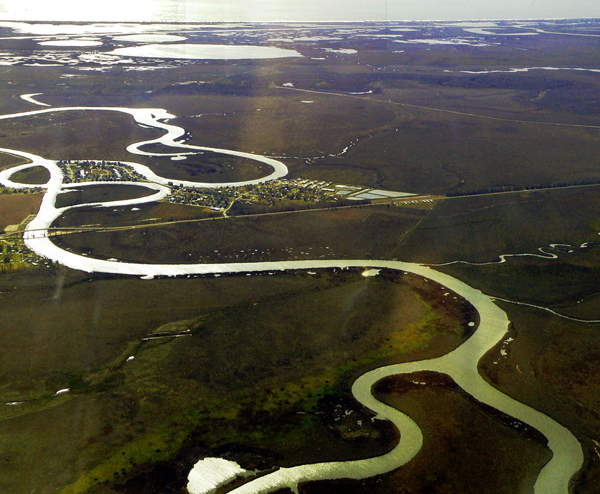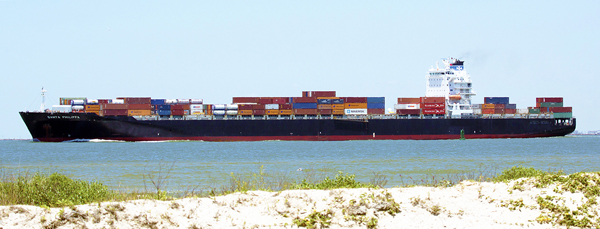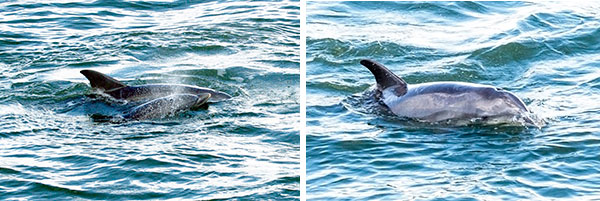Here I am in this great world energy capital: Houston, Texas. Like you, I want to see my grandchildren growing up in a "green and pleasant land" — one not wracked by the destructive effects that follow too much of anything. Our city sits upon a network of bayous that feed into a Ship Channel which, in turn, empties into the Gulf of Mexico at Galveston.
These bayous run full after rainfall and nearly empty during dry spells. Detention basins dot the city, adjacent to the bayous. They absorb water during heavy rains and protect the city from flooding. That water system may, at times, by almost invisible to those of us who live here, but it defines the city.
Each bayou, and each detention basin, is its own nature preserve. And the Ship Channel, America's largest international seaport, is another great nature preserve. All are filled with migratory water birds, fish, porpoises, and other creatures of the wetlands. All that Ship Channel life coexists with the amazing string of refineries and other commerce that lines the Channel.

The torturous meandering of Oyster Creek as it nears the Gulf of Mexico on the flat land of Galveston County. (Photo by Carol Lienhard)
My city is a wild intermingling of nature and industry. We work to keep industry just enough at bay that birds, beasts, and fish can live in harmony with it. As long as that balance is retained, our water-based economy is a complex wonder. And energy remains a delight.

The 67,000 dead-weight-ton container ship, Santa Philippa, one of a constant stream of such ships entering (or leaving) the mouth of the Houston Ship Channel. (Photo by J. H. Lienhard)
The economic heart of Houston has shifted many times during almost two-centuries. Cotton, sulfur, rice, oil, natural gas. All have, at one time or another, been native to the region — all that and still more. Our Ship Channel is the great distribution artery for every product imaginable — incoming and outgoing.

Porpoises are the constant companions of the ships [Photos in the Ship Channel by J. H. Lienhard]
So life in this American energy capital is good. Well, life is probably good where you live, as well. And it will remain so only as long as we have the wits to hear William Blake's admonition: I will not to cease from mental fight. Global climate change is, after all, no theory — no Chicken Little cry. It's a clear reality. And we're left to ask ourselves, Is it a historical outlier? Are we contributors? It probably is and we probably are, though to what extent remains a matter of debate. Still, only a fool can brush that possibility aside when so much is at stake.
So we seek other means to feed our energy habit. Nuclear and renewable power sources are first places to look, of course. Yet each of those brings its own problems. We face safety and waste disposal problems of nuclear energy. And all renewable energy sources are dogged by capital costs and by real-estate consumption.
This is not the forum to tackle those issues. But tackle them we must. I've tried to show that we've faced energy crises in the past with differing results. Sometimes we've prevailed; sometimes those problems have displayed the capacity for inflicting vast damage. I only hope we may have the ongoing wits to keep William Blake's contradictions in mind. Reason he tells us, must be the bound or outward circumference of Energy. Once it is, then Energy really can be Eternal Delight.
Sources
See, e.g. J. H. Lienhard, More Than a Sum of Parts. Cite Magazine, Summer 2009. pp 42-45.
For a slideshow of images of ships and wildlife at the Ship Channel mouth – Galveston Bay, see: http://enginespics.smugmug.com/Travel/Two-Hours-at-the-Mouth-of/31227525_P4bG2j#!i=2702359097&k=zhjt2tZ
Two good sources for data on climate change and human contributions to it:
http://ossfoundation.us/projects/environment/global-warming/natural-cycle
http://data.giss.nasa.gov/gistemp/graphs_v3/